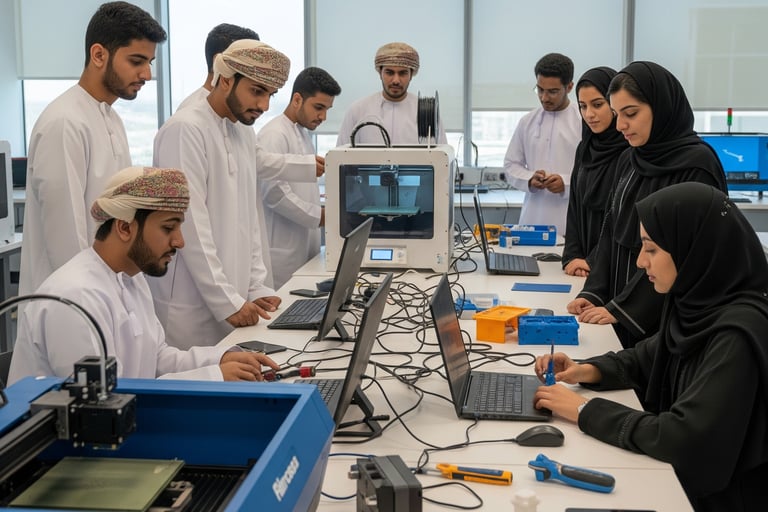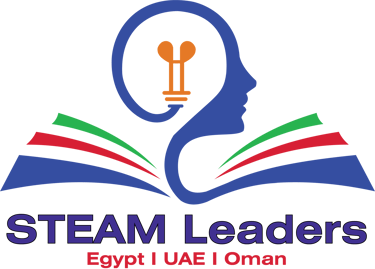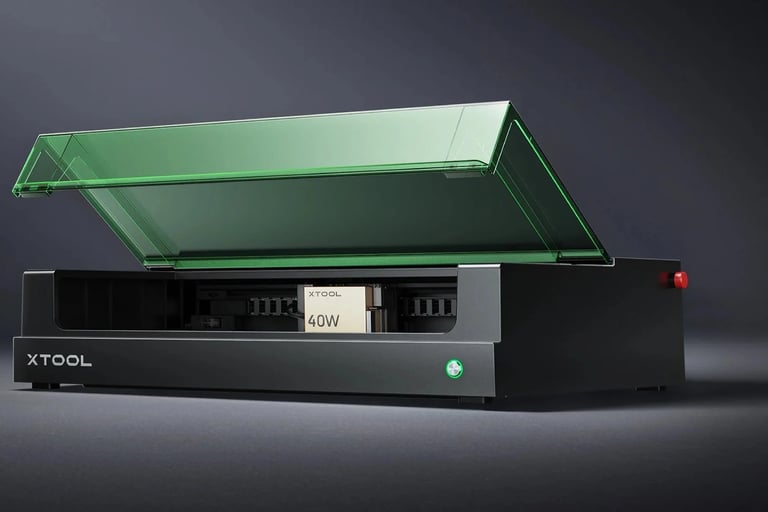From STEM Lab to Digital Fabrication Lab in Oman
In our last guide, we explored the transformative power of a STEM lab—a dynamic space where students move from theory to practice by building, coding, and experimenting. It’s the perfect environment for fostering critical thinking and collaborative skills. But once your students have mastered building a robot or coding a sensor, what comes next? How do we empower them to move from assembling pre-designed kits to creating something entirely new from their own imagination?
Welcome to the next frontier in modern education: the Digital Fabrication Lab, also known as a Fab Lab or Makerspace.
If a STEM lab is where students learn the language of science and technology, a Digital Fabrication Lab is where they become fluent authors, capable of writing their own technological stories. It’s a workshop that bridges the digital world of design with the physical world of creation. Here, students don't just solve problems; they design, prototype, and manufacture their own unique solutions. It is the heart of invention within a school.
A Digital Fabrication Lab is a creative space equipped with computer-controlled tools that allow students to turn their digital designs into physical objects. Instead of just building with pre-made blocks, students can design a custom part on a computer and watch as a machine creates it right before their eyes. This process empowers them to engage in rapid prototyping, iterative design, and customized manufacturing.
The core of a Fab Lab typically revolves around three key technologies: Laser Cutting, CNC Milling, and 3D Printing. Let's explore each one.
What is a Laser Cutter?
A laser cutter is a machine that uses a powerful, focused beam of light to cut, etch, or engrave materials with incredible precision. It can work with a wide range of materials, including wood, acrylic, fabric, leather, and cardboard. Students create a 2D design on a computer, send it to the laser cutter, and the machine follows the digital path to cut or engrave the material exactly as designed.
Our Recommended Platform for Schools: xTool S1 Enclosed Diode Laser Cutter
1. Laser Cutting: Precision and Artistry with Light
Click the image to explore the xTool S1 in our store.
When introducing powerful tools like lasers into a school environment, safety is the number one priority. That’s why we, as the official partner for xTool in Oman, confidently recommend the xTool S1. It is designed from the ground up with classroom safety in mind.
The xTool S1 is a fully enclosed diode laser, which means the laser is contained within a protective, fire-resistant shell with a lid that filters harmful light. This enclosure is the first and most important line of defense. The machine will automatically stop if the lid is opened during operation, ensuring that students are never exposed to the active laser beam.
Furthermore, we always provide the xTool Safety Set Kit alongside the S1. This includes an industrial-grade air purifier that filters out smoke and particles, ensuring clean air quality in the lab, and a fire safety set with automatic fire extinguishers designed for laser cutters. This comprehensive approach to safety makes the xTool S1 the most responsible choice for schools.
Educational Examples:
Architecture
Students can design and cut intricate pieces for architectural models of buildings and bridges.
Art & Design
Create custom jewelry, engraved wooden signs, or detailed fabric patterns for textile projects.
Engineering
Prototype custom chassis parts, gears, and enclosures for their robotics projects.
2. CNC Milling: Subtractive Manufacturing with Precision
What is a CNC Machine?
While laser cutters and 3D printers excel with certain materials, a CNC (Computer Numerical Control) mill is a master of shaping solid blocks of material like wood, plastic, and even soft metals like aluminum. It is a "subtractive" manufacturing tool, meaning it starts with a solid block and carves material away using a spinning cutting tool (like a drill bit) to achieve a final shape. It's incredibly precise and perfect for creating durable, functional parts.
Our Recommended Platform: Carbide3D Nomad 3 - Desktop CNC Mill


Click the image to explore the Nomad 3 in our store.
The Nomad 3 is a perfect CNC mill for the classroom. It is compact enough to fit on a desktop, fully enclosed to contain dust and reduce noise, and comes with user-friendly software that simplifies the process of turning a 3D design into a finished part. Its robust construction means it can create high-quality parts that are strong enough for real-world engineering prototypes.
Educational Examples:
Mechanical Engineering
Mill custom aluminum motor mounts, brackets, and structural components for advanced robotics competitions.
Product Design
Create high-fidelity prototypes of new inventions, from phone cases to ergonomic tool handles.
Art
Carve intricate 3D reliefs and sculptures out of wood.
3. 3D Printing: Additive Manufacturing for Complex Shapes
What is a 3D Printer?
Perhaps the most famous tool in a Fab Lab, a 3D printer is an "additive" manufacturing machine. It builds an object layer by layer from the bottom up, following a 3D digital model. It extrudes melted plastic or other materials, which cool and fuse together to create a solid object. 3D printers are exceptional at creating complex, hollow, or intricate shapes that would be impossible to make with traditional methods.
What is a Digital Fabrication Lab?
Our Recommended Platform: Original Prusa MK4S
Prusa is a legend in the 3D printing community, known for its incredible reliability, high-quality prints, and open-source philosophy. The MK4S is a workhorse machine, perfect for a school lab where it will be running constantly. It's easy to maintain and produces fantastic results every time, making it a dependable choice for both beginners and advanced users.
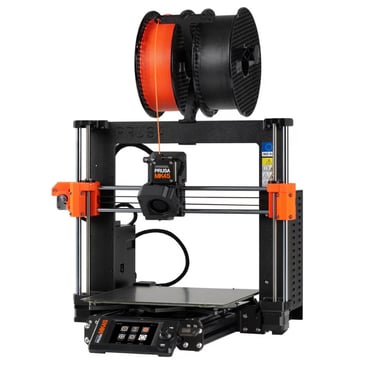

Click the image to explore the Prusa MK4S in our store.
Our Recommended Platform: Bambu Lab X1 Series
For schools looking for speed and multi-color printing capabilities, the Bambu Lab X1 is a game-changer. It is famous for its incredible printing speed without sacrificing quality. Its standout feature is the Automatic Material System (AMS), which allows students to print a single object in multiple colors or materials seamlessly. This opens up a new world of creativity for complex models and prototypes.
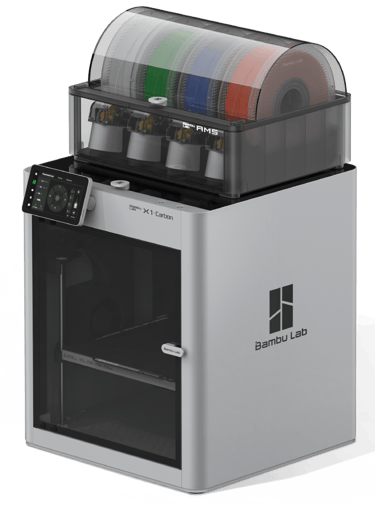

Click the image to explore the Bambu Lab in our store.
Educational Examples:
Biology
Print detailed, accurate models of cells, organs, or dinosaur fossils for hands-on study.
Problem Solving
A student identifies a need in the classroom, like a broken handle on a cupboard. They can design a custom replacement part and 3D print it for a real-world fix.
Custom Robotics
Design and print custom sensor mounts, grippers, and decorative elements to enhance their mBot or other robotics kits.
Let Us Build Your Vision
From the foundational tools of a STEM lab to the advanced creative power of a Digital Fabrication Lab, the goal is to create an ecosystem of learning where students can see their ideas become reality.
At STEAM Leaders, we don’t just supply the machines—we build the entire learning environment. We are proud to partner with schools across Oman to design and set up state-of-the-art STEM and Digital Fabrication labs tailored to your specific curriculum, space, and budget. From selecting the right mix of equipment to providing comprehensive teacher training and ongoing support, we are here to help you build a vibrant hub for the next generation of Omani innovators.
